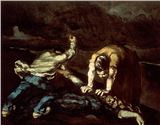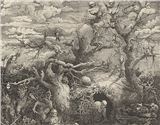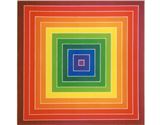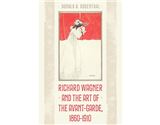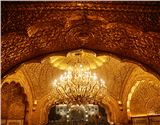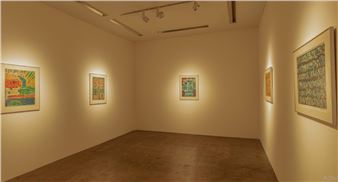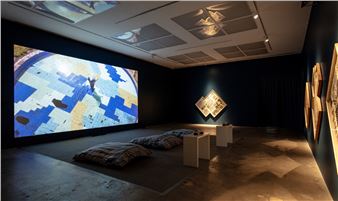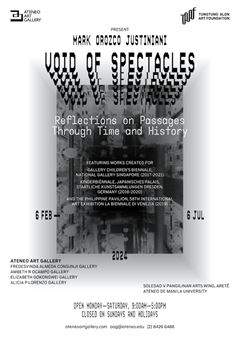Gary-Ross Pastrana: Summa
Silverlens, Manila
Manila | PhilippinesA mandala of seed and grain is formed with trance-like discipline and is carefully laid out, only to be consumed bit by bit by birds. Pages of the dictionary lavished with varnish are shaped like leaves and left to fall on a heap. These are scenes that testify to Gary-Ross Pastrana's keen doubt about the substance of things, its artifice that may be broken down into units and then re-synthesized to become something else like burnt wood mimicking the silhouette of a bird, or gall stones wrought like miniature sculpture.
The artist extends this profound take on things in photography: sugar cubes cobbled together to become a water well; a plate marked by cracks formed by hair; used pencil erasers shaped into a Rubik's cube. He reduces Caspar David Friedrich's painting The Wreck of Hope of a vessel crashing into an iceberg into a puzzle and slides it into the narrow neck of a bottle, with the catastrophic condensed into the picturesque. He borrows two rings from his mother and asks a goldsmith to melt them and sculpt the molten stuff into a small sword. He is captivated by these transformations in the constitution of things, the distillation of essence and traits like malleability or luster, specifically in the fluid mutations that transcend the origin of matter and its appearance.In this exhibition, Pastrana renews his "belief in process" in his sustained meditation on "transcendental themes subjected to sobering, real-world concerns."
He imagines this as a way of probing the "precarious" yet "obstinate" place of installation and ephemeral art in the very liquid world of the art market. This tenacity of art in the face of neoliberal solvency traces the tension in the crystallization of object and its dispersal, the valence of substances and their conditions when they change states and phases, from property or collectible to mere material, from copyright to philanthropy, from anesthesia to abuse. These abstractions are rendered in atmospheric works that are exceptionally granular like a silver dollar ground to dust and congealed on glass via gelatin, sand from hourglasses dissolved by the sea, a document of authorship transferring rights to profit on a supposedly singular creation. These are densely intellectual, yet never affectatiously conceptualist, efforts to free art from its metabolic, self-renewing form.
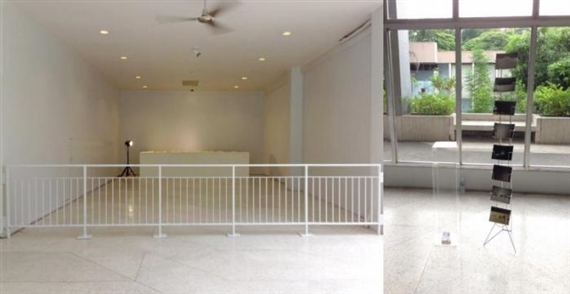
A mandala of seed and grain is formed with trance-like discipline and is carefully laid out, only to be consumed bit by bit by birds. Pages of the dictionary lavished with varnish are shaped like leaves and left to fall on a heap. These are scenes that testify to Gary-Ross Pastrana's keen doubt about the substance of things, its artifice that may be broken down into units and then re-synthesized to become something else like burnt wood mimicking the silhouette of a bird, or gall stones wrought like miniature sculpture.
The artist extends this profound take on things in photography: sugar cubes cobbled together to become a water well; a plate marked by cracks formed by hair; used pencil erasers shaped into a Rubik's cube. He reduces Caspar David Friedrich's painting The Wreck of Hope of a vessel crashing into an iceberg into a puzzle and slides it into the narrow neck of a bottle, with the catastrophic condensed into the picturesque. He borrows two rings from his mother and asks a goldsmith to melt them and sculpt the molten stuff into a small sword. He is captivated by these transformations in the constitution of things, the distillation of essence and traits like malleability or luster, specifically in the fluid mutations that transcend the origin of matter and its appearance.In this exhibition, Pastrana renews his "belief in process" in his sustained meditation on "transcendental themes subjected to sobering, real-world concerns."
He imagines this as a way of probing the "precarious" yet "obstinate" place of installation and ephemeral art in the very liquid world of the art market. This tenacity of art in the face of neoliberal solvency traces the tension in the crystallization of object and its dispersal, the valence of substances and their conditions when they change states and phases, from property or collectible to mere material, from copyright to philanthropy, from anesthesia to abuse. These abstractions are rendered in atmospheric works that are exceptionally granular like a silver dollar ground to dust and congealed on glass via gelatin, sand from hourglasses dissolved by the sea, a document of authorship transferring rights to profit on a supposedly singular creation. These are densely intellectual, yet never affectatiously conceptualist, efforts to free art from its metabolic, self-renewing form.
Artists on show
Contact details



